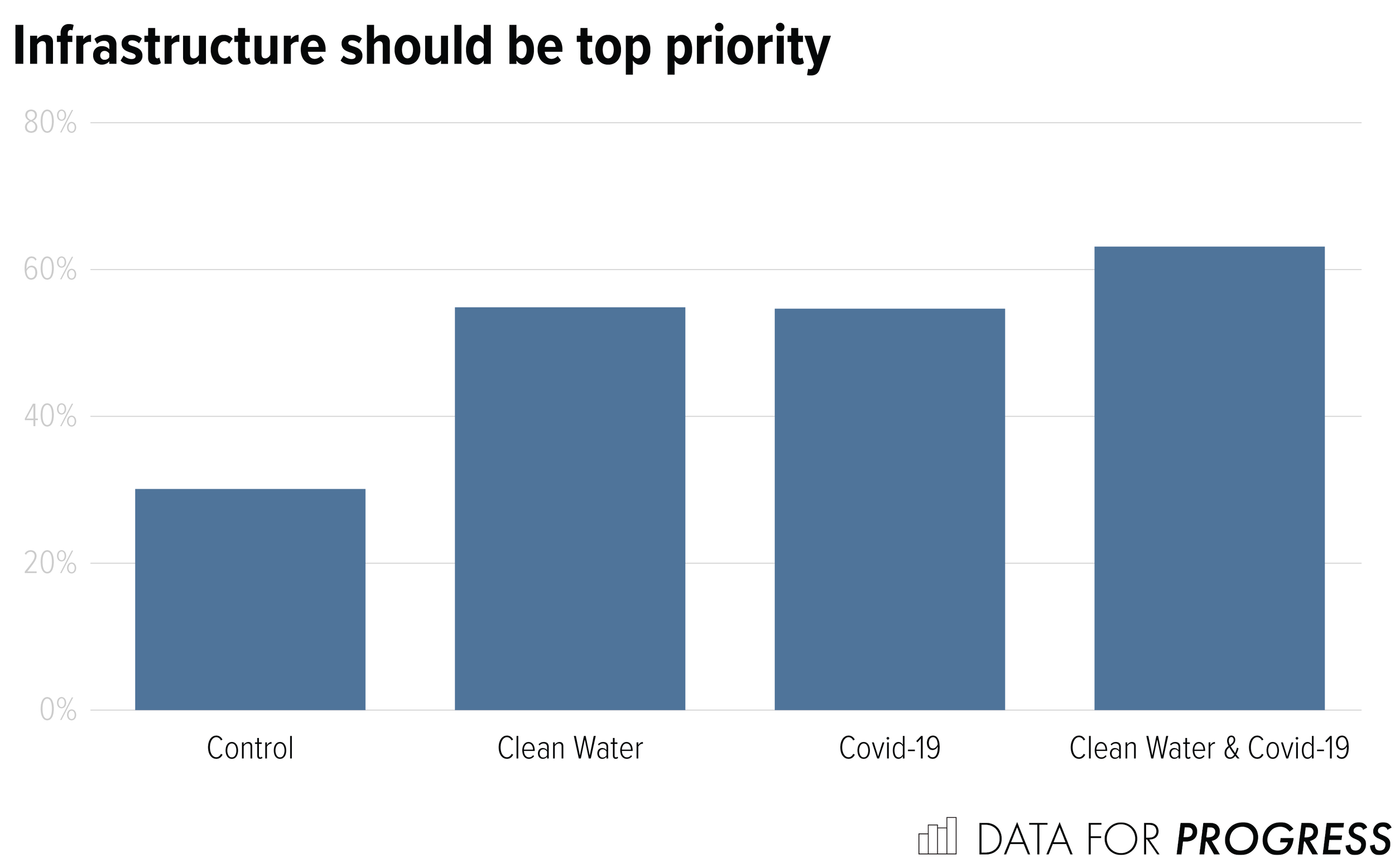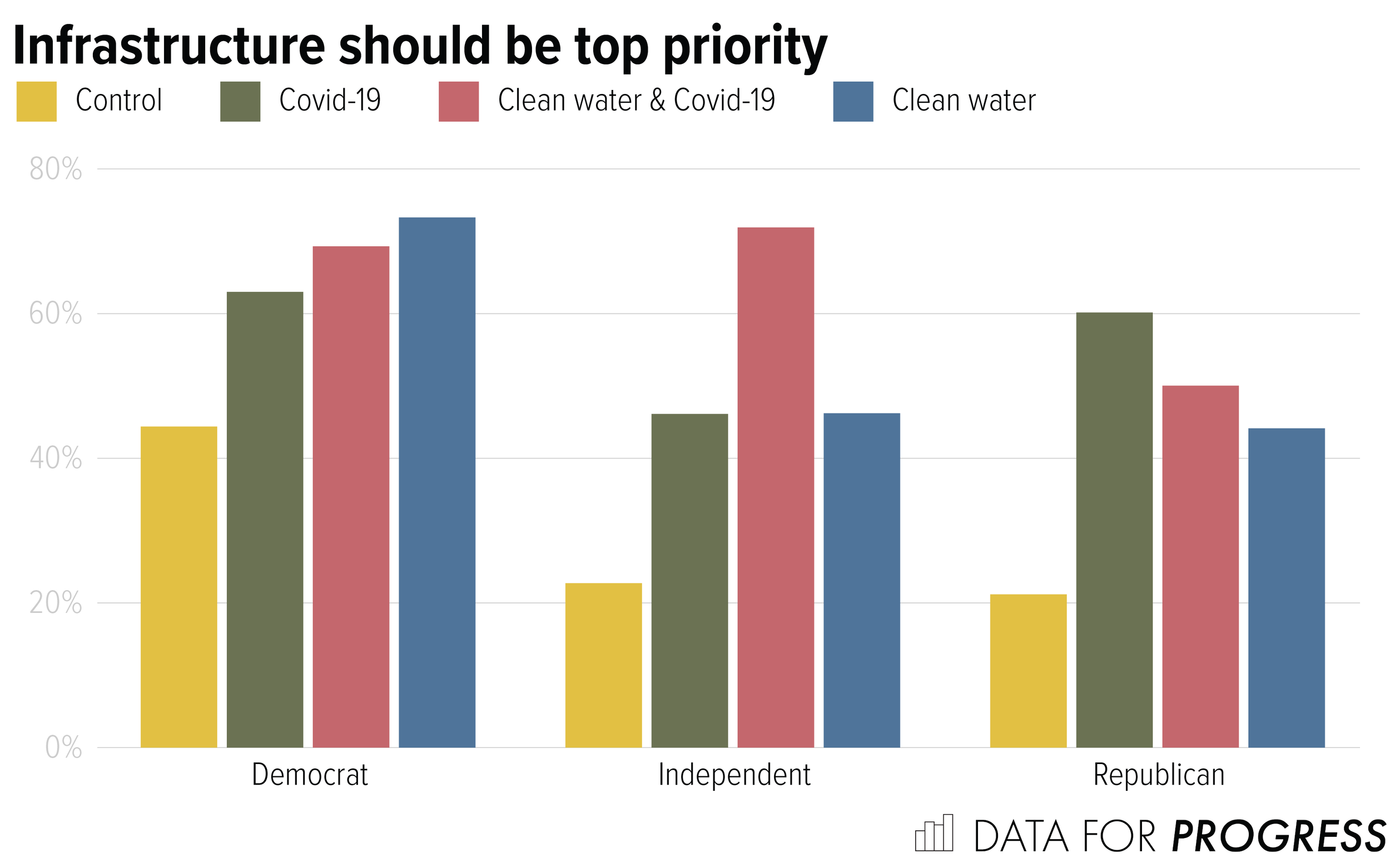Americans Support a Clean Water and Economic Relief Infrastructure Bill
By Benjamin Auerbach, Bennett Fleming Wood, and Lucas Pyle
It is no secret that American infrastructure is crumbling. In both 2013 and 2017, the American Society of Civil Engineers gave the U.S. a D+ grade on its overall infrastructure, showing the severity of America’s need for infrastructure investment. Most recently, a cold snap in Texas unveiled significant flaws in the state’s infrastructure, leading to a power outage that lasted about four days. To make matters worse, about half of the state received a water advisory during this power outage. The devastation in Texas reveals some of the major flaws in U.S. infrastructure: Texan electrical systems are overly reliant on fossil fuels and lack federal funding for electrical infrastructure.
While Texas may have served as a wakeup call for some politicians and voters, infrastructure spending has actually been a top priority for Americans, with broad, bipartisan popularity, since before the 2016 election. In 2019, 96% of likely American voters said infrastructure spending is at least somewhat important. And in March of 2020, polling by Vox and Data for Progress found that 62% of Americans supported spending $100 billion dollars per year for 10 years on infrastructure.
Despite the broad popular support for infrastructure spending, President Trump failed to focus on it, instead choosing not to continue President Obama’s FAST Act, which funds national transportation projects. President Biden, however, recently re-upped his commitment to a massive infrastructure bill that would be “a national effort aimed at creating the jobs we need to build a modern, sustainable infrastructure now and deliver an equitable clean energy future.”
Biden’s bill, regardless of high bipartisan support amongst voters, would still likely face Republican filibusters in the Senate. As such, increasing favorability for his infrastructure package is essential for Biden’s success. While infrastructure spending is already highly popular, Biden has a unique opportunity to further increase public support for a much-needed infrastructure package by focusing his messaging on the issues Americans care about.
We set out to examine how framing infrastructure bills with specific policy points impacts public support. We created 4 survey treatments. Our control asked respondents if they felt that infrastructure spending should be a priority, but did not elaborate on the specifics of the bill. The next three asked the same question, but added that the bill would specifically focus on clean water, COVID-19 related economic relief, and a combination of the two. Our results show that while Americans are supportive of infrastructure generally, support increases greatly when we talk about these important issues.
The above figure depicts the percentage of respondents saying that an infrastructure bill should be a top priority for Congress by treatment groups, and shows that providing a framing for infrastructure spending greatly increases its popularity. While only a third of respondents in the control group agreed that the bill should be a top priority for Congress, almost 55% of respondents said that infrastructure bills focusing on just Covid-19 or just clean water relief should be a top priority. An astounding 63% of respondents supported an infrastructure bill that focuses on both Covid-19 and clean water relief as a top priority for Congress. We found statistically significant increases in support between all three of the treatment groups and the control. Providing context for infrastructure spending greatly increases its popularity, revealing opportunities for the Biden Administration to improve public reception of his upcoming infrastructure package by focusing on the issues Americans care most about.
Next, we wanted to explore any additional factors that might predict prioritizing an infrastructure bill. We ran a linear regression, pictured below, to test the impacts of our survey treatment conditions, along with age, gender, education, and political party. Of these factors, race was not statistically significant on respondents’ prioritizing of infrastructure.
The regression results show that people are more likely to view an infrastructure bill as a top priority if it is framed with clean water or providing economic relief during the pandemic even after controlling for education, age, and party. Respondents in the clean water treatment were 14-points more likely to say that infrastructure spending should be a priority. Our Covid-19 economic relief treatment had similar effects: respondents in that category were 10-points more likely to say an infrastructure bill should be a top priority for Congress. Finally, we also saw significant effects from the treatment that combines clean water and economic relief with an increase in support of 13-points over the control.
Party identification also impacts one’s view on infrastructure being a top legislative priority. Independents are 7-points less likely to view infrastructure as a top priority, while Republicans are 8-points less likely. Age and education also determine one’s view on infrastructure legislation. Support for infrastructure increases by 0.13-points for each year older the respondent gets. Those with higher levels of education are 2-points more likely to view infrastructure as an important legislative priority.
Our linear regression shows that partisanship is statistically significant and a deeper dive shows that different political parties are swayed more by different infrastructure bill framings. The following figure shows the percentage of respondents who agree infrastructure should be a top priority by political party and treatment group.
Democrats are the most supportive of infrastructure spending generally — almost 45% of Democrats in the control group said infrastructure should be a top priority, while slightly over 20% of both Republicans and Independents agreed. Notably, Democrats are particularly convinced by the framing including clean water, with almost 75% saying an infrastructure bill focusing on clean water should be a top priority for Congress.
Independents and Republicans also greatly increase their support for infrastructure when provided with context and framing for an infrastructure spending bill. Independents were the most supportive of an infrastructure bill in the treatment group that combined Covid-19 relief and clean water legislation: over 70% of Independents said infrastructure focusing on both Covid-19 and clean water should be a top priority, an almost 50-point increase from the control group.
Republicans, unsurprisingly, responded most enthusiastically to the economic framing of the bill. GOP support for infrastructure spending increased 40-points between the control group and the COVID-19 economic relief treatment, with over 60% of respondents saying infrastructure spending focused on COVID-19 relief should be a top priority for Congress.
Across the board, providing some framing increased support for infrastructure spending even though different partisans favored different framings. It is clear that voters overwhelmingly support an infrastructure bill, especially when it focuses on issues that they care about.
We also wanted to see which infrastructure projects Americans would most want to see in a bill. We asked survey respondents to pick their priority out of two randomly offered infrastructure project types. There were 14 possible projects and respondents were asked to make a binary choice five separate times. For instance, respondents would be forced to choose between improving highways and building high-speed rail. While choosing to improve highways in this instance does not mean a respondent opposes high-speed rail, this design gives us a good idea of what Americans would prioritize in an infrastructure bill when forced to make trade-offs.
The results are striking, and they reveal a broad consensus on a few issues. The two highest priority projects both involve water infrastructure — when “clean water infrastructure” or “replacing lead drinking water lines” were offered, respondents chose them about 70 percent of the time. Recent polling supports our findings — a survey by the Value of Water Campaign from April of 2020 found that almost 85% of Americans support clean water infrastructure. Other strong contenders in our experiment are highway and road improvement, environmental cleanup, affordable housing, and modernizing the power grid. Respondents chose these projects more than half of the time.
We decided to dig deeper to see what people from different communities think about infrastructure priorities. Cities, suburbs, and rural areas often have different infrastructure needs. However, when dividing our data by community type, we still found a great deal of common ground. Unsurprisingly, city-dwellers are more likely to prioritize transit spending, and rural-dwellers would love some improved roads, but for each community type, clean-water infrastructure and replacing lead pipes receives around 70 percent priority.
At the bottom of respondents’ priorities were transit and rail-related projects, along with the construction of new highways. The lowest was high-speed passenger rail. This may disappoint transit or rail-oriented observers, but this likely reflects low transit use in present-day America.
Nevertheless, any passable infrastructure bill will bring together all different types of constituencies. Any infrastructure bill that is passed by Congress will devote resources to most, if not all, of these types of projects. But when it comes to messaging and overall funding priorities, Congressional leadership will have strong support from voters across all parties on water, roads, and the environment.
Benjamin Auerbach (@bnarbac) is a student at Tufts University, Class of 2021.
Bennett Fleming Wood (@bennettfw36) is a student at Tufts University, Class of 2021.
Lucas Pyle (@Lucasbenji17) is a student at Tufts University, Class of 2021.




